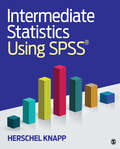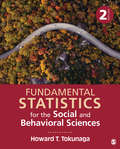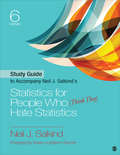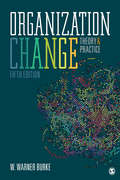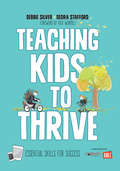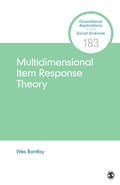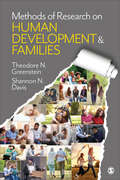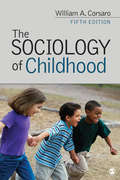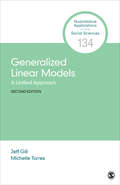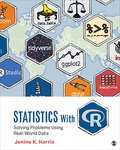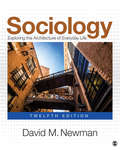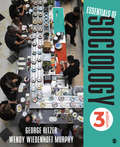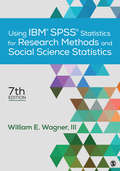- Table View
- List View
Intermediate Statistics Using SPSS
by Herschel KnappWhat statistical test should I use for this kind of data? How do I set up the data? What parameters should I specify when ordering the test? How do I interpret the results? Herschel Knapp's friendly and approachable guide to real-world statistics answers these questions. Intermediate Statistics Using SPSS is not about abstract statistical theory or the derivation or memorization of statistical formulas–it is about applied statistics. With jargon-free language and clear processing instructions, this text covers the most common statistical functions–from basic to more advanced. Practical exercises at the conclusion of each chapter offer students an opportunity to process viable data sets, write cohesive abstracts in APA style, and build a thorough comprehension of the statistical process. You will learn by doing with this truly practical approach to statistics.
Intermediate Statistics Using SPSS
by Herschel KnappWhat statistical test should I use for this kind of data? How do I set up the data? What parameters should I specify when ordering the test? How do I interpret the results? Herschel Knapp's friendly and approachable guide to real-world statistics answers these questions. Intermediate Statistics Using SPSS is not about abstract statistical theory or the derivation or memorization of statistical formulas–it is about applied statistics. With jargon-free language and clear processing instructions, this text covers the most common statistical functions–from basic to more advanced. Practical exercises at the conclusion of each chapter offer students an opportunity to process viable data sets, write cohesive abstracts in APA style, and build a thorough comprehension of the statistical process. You will learn by doing with this truly practical approach to statistics.
Fundamental Statistics for the Social and Behavioral Sciences
by Howard T. TokunagaFundamental Statistics for the Social and Behavioral Sciences, Second Edition places statistics within the research process, illustrating how they are used to answer questions and test ideas. Students learn not only how to calculate statistics, but also how to interpret and communicate the results of statistical analyses in light of a study’s research hypothesis. Featuring accessible writing and well-integrated research examples, the book gives students a greater understanding of how research studies are conceived, conducted, and communicated. New and Proven Features Updated data sets and research examples address real-world issues and topics across the social and behavioral sciences, illustrating the use of statistical procedures to test research questions and hypotheses. Significantly expanded discussion of linear and multiple regression and correlation now gives regression its own separate chapter. Thorough presentation of formulas, hand calculations, and the presentation of visual data enable mastery of key techniques and prove especially helpful in flipped or online classes. In-chapter learning checks and end-of-chapter exercises give students an opportunity to continually assess their understanding. Screenshots of statistical calculations using IBM® SPSS® Statistics at the end of chapters help students learn to use SPSS software and interpret output. Original SAGE videos for each chapter, featuring author Howard K. Tokunaga, bring concepts to life and appeal to diverse learners.
Fundamental Statistics for the Social and Behavioral Sciences
by Howard T. TokunagaFundamental Statistics for the Social and Behavioral Sciences, Second Edition places statistics within the research process, illustrating how they are used to answer questions and test ideas. Students learn not only how to calculate statistics, but also how to interpret and communicate the results of statistical analyses in light of a study’s research hypothesis. Featuring accessible writing and well-integrated research examples, the book gives students a greater understanding of how research studies are conceived, conducted, and communicated. New and Proven Features Updated data sets and research examples address real-world issues and topics across the social and behavioral sciences, illustrating the use of statistical procedures to test research questions and hypotheses. Significantly expanded discussion of linear and multiple regression and correlation now gives regression its own separate chapter. Thorough presentation of formulas, hand calculations, and the presentation of visual data enable mastery of key techniques and prove especially helpful in flipped or online classes. In-chapter learning checks and end-of-chapter exercises give students an opportunity to continually assess their understanding. Screenshots of statistical calculations using IBM® SPSS® Statistics at the end of chapters help students learn to use SPSS software and interpret output. Original SAGE videos for each chapter, featuring author Howard K. Tokunaga, bring concepts to life and appeal to diverse learners.
Study Guide to Accompany Neil J. Salkind's Statistics for People Who (Think They) Hate Statistics
by Dr Neil J. SalkindThe Study Guide to Accompany Neil J. Salkind's Statistics for People Who (Think They) Hate Statistics, Sixth Edition includes chapter outlines; chapter summaries; learning objectives; key terms; exercises; true/false, multiple choice, and essay questions; as well as answers to all questions. The guide has been updated to match the organization of Salkind’s text and includes activities for the book's new Chapter 19: Data Mining: An Introduction to Getting the Most Out of Your BIG Data.
Study Guide to Accompany Neil J. Salkind's Statistics for People Who (Think They) Hate Statistics
by Dr Neil J. SalkindThe Study Guide to Accompany Neil J. Salkind's Statistics for People Who (Think They) Hate Statistics, Sixth Edition includes chapter outlines; chapter summaries; learning objectives; key terms; exercises; true/false, multiple choice, and essay questions; as well as answers to all questions. The guide has been updated to match the organization of Salkind’s text and includes activities for the book's new Chapter 19: Data Mining: An Introduction to Getting the Most Out of Your BIG Data.
Organization Change: Theory and Practice
by W. Warner BurkeChange is a constant in today's organizations. Leaders, managers, and employees at all levels must understand both how to implement planned changed and effectively handle unexpected change. The Fifth Edition of the Organization Change: Theory and Practice provides an eye-opening exploration into the nature of change by presenting the latest evidence-based research to discuss a range of theories, models, and perspectives on organization change. Bestselling author, W. Warner Burke, skillfully connects theory to practice with modern cases of effective and ineffective organization change, recent examples of transformational leadership and planned and revolutionary change, and best practices to successfully influence change. This fully-updated new edition also includes a new chapter on healthcare and government organizations, offering practical applications for non-profit organizations.
Organization Change: Theory and Practice
by W. Warner BurkeChange is a constant in today's organizations. Leaders, managers, and employees at all levels must understand both how to implement planned changed and effectively handle unexpected change. The Fifth Edition of the Organization Change: Theory and Practice provides an eye-opening exploration into the nature of change by presenting the latest evidence-based research to discuss a range of theories, models, and perspectives on organization change. Bestselling author, W. Warner Burke, skillfully connects theory to practice with modern cases of effective and ineffective organization change, recent examples of transformational leadership and planned and revolutionary change, and best practices to successfully influence change. This fully-updated new edition also includes a new chapter on healthcare and government organizations, offering practical applications for non-profit organizations.
Teaching Kids to Thrive: Essential Skills for Success
by Debbie Thompson Silver Ms Dedra A. StaffordThere’s more to student success than standards and test scores… Integrating Social and Emotional Learning into a curriculum has been shown to increase personal and school-wide growth. With lifelong success the goal over simply meeting academic thresholds, Teaching Kids to Thrive presents strategies, activities, and stories in an approachable way to develop responsible, self-motivated learners. Uniting social, academic, and self-skills this instrumental resource offers benefits to students such as: Using mindfulness strategies to help students tap their inner strengths Learning to self-regulate and control other executive brain functions Developing growth mindsets along with perseverance and resilience Cultivating a sense of responsibility, honesty, and integrity Encouraging a capacity for empathy and gratitude
Teaching Kids to Thrive: Essential Skills for Success
by Debbie Thompson Silver Ms Dedra A. StaffordThere’s more to student success than standards and test scores… Integrating Social and Emotional Learning into a curriculum has been shown to increase personal and school-wide growth. With lifelong success the goal over simply meeting academic thresholds, Teaching Kids to Thrive presents strategies, activities, and stories in an approachable way to develop responsible, self-motivated learners. Uniting social, academic, and self-skills this instrumental resource offers benefits to students such as: Using mindfulness strategies to help students tap their inner strengths Learning to self-regulate and control other executive brain functions Developing growth mindsets along with perseverance and resilience Cultivating a sense of responsibility, honesty, and integrity Encouraging a capacity for empathy and gratitude
Multidimensional Item Response Theory (Quantitative Applications in the Social Sciences #183)
by Wes BonifaySeveral decades of psychometric research have led to the development of sophisticated models for multidimensional test data, and in recent years, multidimensional item response theory (MIRT) has become a burgeoning topic in psychological and educational measurement. Considered a cutting-edge statistical technique, the methodology underlying MIRT can be complex, and therefore doesn&’t receive much attention in introductory IRT courses. However author Wes Bonifay shows how MIRT can be understood and applied by anyone with a firm grounding in unidimensional IRT modeling. His volume includes practical examples and illustrations, along with numerous figures and diagrams. Multidimensional Item Response Theory includes snippets of R code interspersed throughout the text (with the complete R code included on an accompanying website) to guide readers in exploring MIRT models, estimating the model parameters, generating plots, and implementing the various procedures and applications discussed throughout the book.
Multidimensional Item Response Theory (Quantitative Applications in the Social Sciences #183)
by Wes BonifaySeveral decades of psychometric research have led to the development of sophisticated models for multidimensional test data, and in recent years, multidimensional item response theory (MIRT) has become a burgeoning topic in psychological and educational measurement. Considered a cutting-edge statistical technique, the methodology underlying MIRT can be complex, and therefore doesn&’t receive much attention in introductory IRT courses. However author Wes Bonifay shows how MIRT can be understood and applied by anyone with a firm grounding in unidimensional IRT modeling. His volume includes practical examples and illustrations, along with numerous figures and diagrams. Multidimensional Item Response Theory includes snippets of R code interspersed throughout the text (with the complete R code included on an accompanying website) to guide readers in exploring MIRT models, estimating the model parameters, generating plots, and implementing the various procedures and applications discussed throughout the book.
Methods of Research on Human Development and Families
by Shannon N. Davis Theodore N. GreensteinMethods of Research on Human Development and Families is an introduction to quantitative and qualitative research methods that teaches readers how to be intelligent and critical consumers of research on families. This new book has been adapted from the author team’s previous SAGE text, Methods of Family Research, and includes applications and examples from both family science and human development research. With a focus on interpreting and understanding research techniques rather than doing research, this text illustrates how research on families is conducted and helps students gain the competence and confidence to effectively read, interpret, and critique published research reports.
The Sociology of Childhood (Sociology for a New Century Series)
by William CorsaroWilliam A. Corsaro’s groundbreaking text, The Sociology of Childhood, discusses children and childhood from a sociological perspective. Corsaro provides in-depth coverage of the social theories of childhood, the peer cultures and social issues of children and youth, children and childhood within the frameworks of culture and history, and social problems and the future of childhood. The Fifth Edition has been thoroughly updated to incorporate the latest research and the most pertinent information so readers can engage in powerful discussions on a wide array of topics.
The Sociology of Childhood (Sociology for a New Century Series)
by William CorsaroWilliam A. Corsaro’s groundbreaking text, The Sociology of Childhood, discusses children and childhood from a sociological perspective. Corsaro provides in-depth coverage of the social theories of childhood, the peer cultures and social issues of children and youth, children and childhood within the frameworks of culture and history, and social problems and the future of childhood. The Fifth Edition has been thoroughly updated to incorporate the latest research and the most pertinent information so readers can engage in powerful discussions on a wide array of topics.
Generalized Linear Models: A Unified Approach (Quantitative Applications in the Social Sciences #134)
by Professor Jeff Gill Michelle TorresGeneralized Linear Models: A Unified Approach provides an introduction to and overview of GLMs, with each chapter carefully laying the groundwork for the next. Authors Jeff Gill and Michelle Torres provide examples using real data from multiple fields in the social sciences such as psychology, education, economics, and political science, including data on voting intentions in the 2016 U.S. Republican presidential primaries. The Second Edition also strengthens material on the exponential family form, including a new discussion on the multinomial distribution; adds more information on how to interpret results and make inferences in the chapter on estimation procedures; and has a new section on extensions to generalized linear models.
Generalized Linear Models: A Unified Approach (Quantitative Applications in the Social Sciences #134)
by Professor Jeff Gill Michelle TorresGeneralized Linear Models: A Unified Approach provides an introduction to and overview of GLMs, with each chapter carefully laying the groundwork for the next. Authors Jeff Gill and Michelle Torres provide examples using real data from multiple fields in the social sciences such as psychology, education, economics, and political science, including data on voting intentions in the 2016 U.S. Republican presidential primaries. The Second Edition also strengthens material on the exponential family form, including a new discussion on the multinomial distribution; adds more information on how to interpret results and make inferences in the chapter on estimation procedures; and has a new section on extensions to generalized linear models.
Statistics With R: Solving Problems Using Real-World Data
by Jenine K. HarrisDrawing on examples from across the social and behavioral sciences, Statistics with R: Solving Problems Using Real-World Data by Jenine K. Harris introduces foundational statistics concepts with beginner-friendly R programming in an exploration of the world&’s tricky problems faced by the &“R Team&” characters. Inspired by the programming group &“R Ladies,&” the R Team works together to master the skills of statistical analysis and data visualization to untangle real-world, messy data using R. The storylines draw students into investigating contemporary issues such as marijuana legalization, voter registration, and the opioid epidemic, and lead them step-by-step through full-color illustrations of R statistics and interactive exercises.
Statistics With R: Solving Problems Using Real-World Data
by Jenine K. HarrisDrawing on examples from across the social and behavioral sciences, Statistics with R: Solving Problems Using Real-World Data by Jenine K. Harris introduces foundational statistics concepts with beginner-friendly R programming in an exploration of the world&’s tricky problems faced by the &“R Team&” characters. Inspired by the programming group &“R Ladies,&” the R Team works together to master the skills of statistical analysis and data visualization to untangle real-world, messy data using R. The storylines draw students into investigating contemporary issues such as marijuana legalization, voter registration, and the opioid epidemic, and lead them step-by-step through full-color illustrations of R statistics and interactive exercises.
Sociology: Exploring the Architecture of Everyday Life
by Dr David M. NewmanIn Sociology: Exploring the Architecture of Everyday Life, David M. Newman shows students how to see the "unfamiliar in the familiar"—to step back and see organization and predictability in their take-for-granted personal experiences. With his approachable writing style and lively personal anecdotes, the author's goal from the first edition has always been the same: to write a textbook that, in his words, "reads like a real book." Newman uses the metaphors of "architecture" and "construction," to help students understand that society is not something that just exists "out there," independently of themselves; it is a human creation that is planned, maintained, or altered by individuals. Using vivid prose, examples from current events, and the latest research findings, this fully updated Twelfth Edition presents a unique and thought-provoking overview of how society is constructed and experienced. Instead of surveying every subfield in sociology, the more streamlined coverage focuses on the individual and society, the construction of self and society, and social inequality in the context of social structures.
Sociology: Exploring the Architecture of Everyday Life
by Dr David M. NewmanIn Sociology: Exploring the Architecture of Everyday Life, David M. Newman shows students how to see the "unfamiliar in the familiar"—to step back and see organization and predictability in their take-for-granted personal experiences. With his approachable writing style and lively personal anecdotes, the author's goal from the first edition has always been the same: to write a textbook that, in his words, "reads like a real book." Newman uses the metaphors of "architecture" and "construction," to help students understand that society is not something that just exists "out there," independently of themselves; it is a human creation that is planned, maintained, or altered by individuals. Using vivid prose, examples from current events, and the latest research findings, this fully updated Twelfth Edition presents a unique and thought-provoking overview of how society is constructed and experienced. Instead of surveying every subfield in sociology, the more streamlined coverage focuses on the individual and society, the construction of self and society, and social inequality in the context of social structures.
Essentials of Sociology
by Dr George Ritzer Dr Wendy A. Wiedenhoft MurphyEssentials of Sociology, adapted from George Ritzer’s Introduction to Sociology, provides the same rock-solid foundation from one of sociology's best-known thinkers in a shorter and more streamlined format. With new co-author Wendy Wiedenhoft Murphy, the Third Edition continues to illuminate traditional sociological concepts and theories and focuses on some of the most compelling features of contemporary social life: globalization, consumer culture, the internet, and the “McDonaldization” of society. New to this Edition New “Trending” boxes focus on influential books by sociologists that have become part of the public conversation about important issues. Replacing “Public Sociology” boxes, this feature demonstrates the diversity of sociology's practitioners, methods, and subject matter, featuring such authors as o Michelle Alexander (The New Jim Crow) o Elizabeth Armstrong and Laura Hamilton (Paying for the Party) o Matthew Desmond (Evicted) o Arlie Hochschild (Strangers in Their Own Land) o Eric Klinenberg (Going Solo) o C.J. Pascoe (Dude, You're a Fag) o Lori Peek and Alice Fothergill (Children of Katrina) o Allison Pugh (The Tumbleweed Society) Updated examples in the text and "Digital Living" boxes keep pace with changes in digital technology and online practices, including Uber, Bitcoin, net neutrality, digital privacy, WikiLeaks, and cyberactivism. New or updated subjects apply sociological thinking to the latest issues including: the 2016 U.S. election Brexit the global growth of ISIS climate change further segmentation of wealthy Americans as the "super rich" transgender people in the U.S. armed forces charter schools the legalization of marijuana the Flint water crisis fourth-wave feminism
Essentials of Sociology
by Dr George Ritzer Dr Wendy A. Wiedenhoft MurphyEssentials of Sociology, adapted from George Ritzer’s Introduction to Sociology, provides the same rock-solid foundation from one of sociology's best-known thinkers in a shorter and more streamlined format. With new co-author Wendy Wiedenhoft Murphy, the Third Edition continues to illuminate traditional sociological concepts and theories and focuses on some of the most compelling features of contemporary social life: globalization, consumer culture, the internet, and the “McDonaldization” of society. New to this Edition New “Trending” boxes focus on influential books by sociologists that have become part of the public conversation about important issues. Replacing “Public Sociology” boxes, this feature demonstrates the diversity of sociology's practitioners, methods, and subject matter, featuring such authors as o Michelle Alexander (The New Jim Crow) o Elizabeth Armstrong and Laura Hamilton (Paying for the Party) o Matthew Desmond (Evicted) o Arlie Hochschild (Strangers in Their Own Land) o Eric Klinenberg (Going Solo) o C.J. Pascoe (Dude, You're a Fag) o Lori Peek and Alice Fothergill (Children of Katrina) o Allison Pugh (The Tumbleweed Society) Updated examples in the text and "Digital Living" boxes keep pace with changes in digital technology and online practices, including Uber, Bitcoin, net neutrality, digital privacy, WikiLeaks, and cyberactivism. New or updated subjects apply sociological thinking to the latest issues including: the 2016 U.S. election Brexit the global growth of ISIS climate change further segmentation of wealthy Americans as the "super rich" transgender people in the U.S. armed forces charter schools the legalization of marijuana the Flint water crisis fourth-wave feminism
Using IBM® SPSS® Statistics for Research Methods and Social Science Statistics
by Dr. William E. WagnerUsing IBM SPSS for Social Statistics and Research Methods supports the use of SPSS for social statistics and research methods classes and is an excellent companion to any undergraduate statistics or research methods textbook. The book covers a wide range of data analysis topics to help students working on papers, research projects, and proposals. Using examples, tables, and actual SPSS screen captures, along with current data sets from the General Social Survey, it guides users through several different kinds of SPSS files including data files, output files, and syntax files.
Using IBM® SPSS® Statistics for Research Methods and Social Science Statistics
by Dr. William E. WagnerUsing IBM SPSS for Social Statistics and Research Methods supports the use of SPSS for social statistics and research methods classes and is an excellent companion to any undergraduate statistics or research methods textbook. The book covers a wide range of data analysis topics to help students working on papers, research projects, and proposals. Using examples, tables, and actual SPSS screen captures, along with current data sets from the General Social Survey, it guides users through several different kinds of SPSS files including data files, output files, and syntax files.
